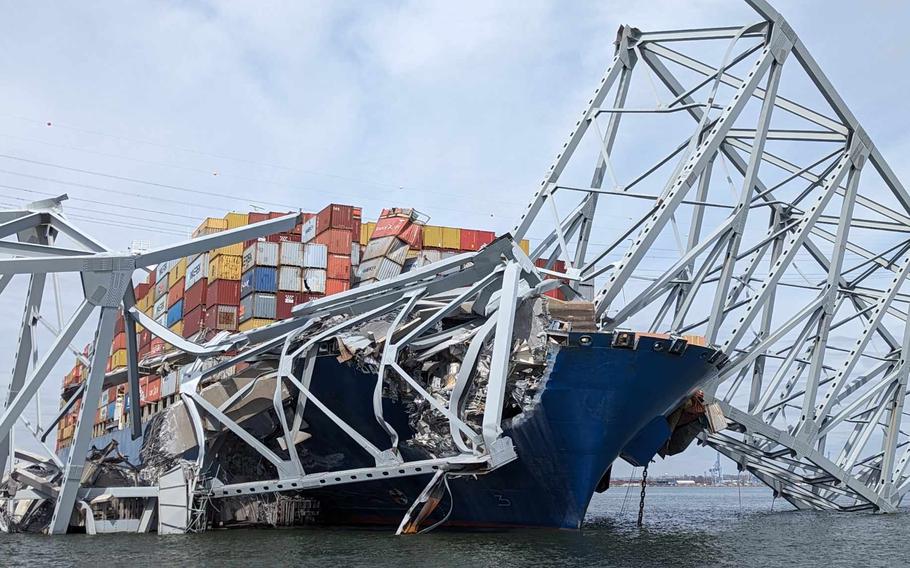
The damage resulting from the collapse of the Francis Scott Key Bridge in Baltimore as observed from the deck of the U.S. Army Corps of Engineers' hydrographic survey vessel Catlett on March 26, 2024. The short-term impact of the accident on military transportation, including the transfer of household goods and privately owned vehicles, is expected to be minimal, U.S. Transportation Command said Friday. (David Adams/U.S. Army Corps of Engineers)
The movement of military household goods and personal vehicles has faced disruptions in the wake of the recent Francis Scott Key Bridge collapse in Baltimore, though immediate impacts appear to be slight, U.S. Transportation Command said Friday.
The bridge suffered catastrophic damage early Tuesday when the cargo ship Dali collided with a support pillar, leading to an indefinite suspension of vessel traffic at the Port of Baltimore.
The port and its Seagirt Marine Terminal are a key node for the national supply chain networks. Along with the I-695 corridor, which the bridge was part of, they are crucial for facilitating the movement of people and goods along the East Coast.
Shipments that may be affected by the collapse are being identified, and military personnel will be notified of any changes to when they’ll receive their goods, command officials said.
“Short term impacts on U.S. Transportation Command missions, including the transportation of household goods and privately owned vehicles, are minimal as these missions can be redirected to other ports on the East Coast,” said Scott D. Ross, a TRANSCOM spokesman.
The command’s shipping contractors, meanwhile, are seeking alternative ports and modes of transportation, such as rail and truck, to reduce the impact on shipments, officials said.
“We anticipate increased congestion at alternate ports due to the loss of access to the Port of Baltimore. However, we assess that the vast majority of potential impacts can be mitigated through our extensive transportation network and by prudent planning and continued communication with our industry partners,” Ross said.
International Auto Logistics, the contractor responsible for shipping privately owned vehicles, reported that none of its cargo was aboard the Dali. The company is also seeking alternative shipping routes to minimize delays.
All carriers using Baltimore as their primary port are now competing for the same resources at other ports, IAL said, and a decision on where to move operations requires that adequate port space and resources be available to stage vehicle cargo.
“Our customer service team will be reaching out to all customers who may experience delivery delays due to this incident as soon as more information becomes available,” the company said in a statement Wednesday.
The incident precedes the military’s peak moving season, which ramps up in mid-May, raising concerns about potential effects on military movers in the months to come.
While shipments may be diverted over the short term, the rebuilding of the Key Bridge could take years, officials said.
The bridge served as an essential artery for daily travel for thousands in the Baltimore-Washington area.
The reopening of the Port of Baltimore is expected to precede the bridge’s restoration, providing some relief to affected logistical operations, Department of Transportation officials said.
The Singapore-flagged container ship Dali is about the length of three football fields and is now covered with up to 4,000 tons of mangled steel of the bridge.
Authorities believe at least four victims of the sudden bridge collapse remain trapped within the submerged wreckage of steel and concrete.
The U.S. Army Corps of Engineers mobilized over 1,100 specialists in engineering, construction, contracting and operations to assist local, state and federal agencies in the recovery efforts, the service said.
The Corps of Engineers is also coordinating the removal of bridge debris and clearing of the waterway.